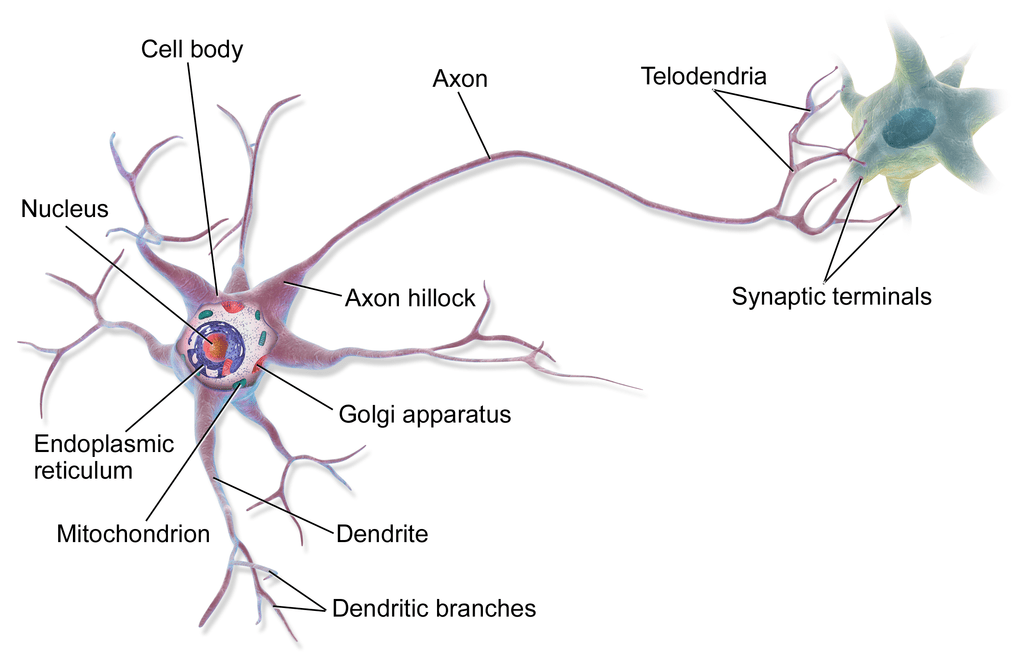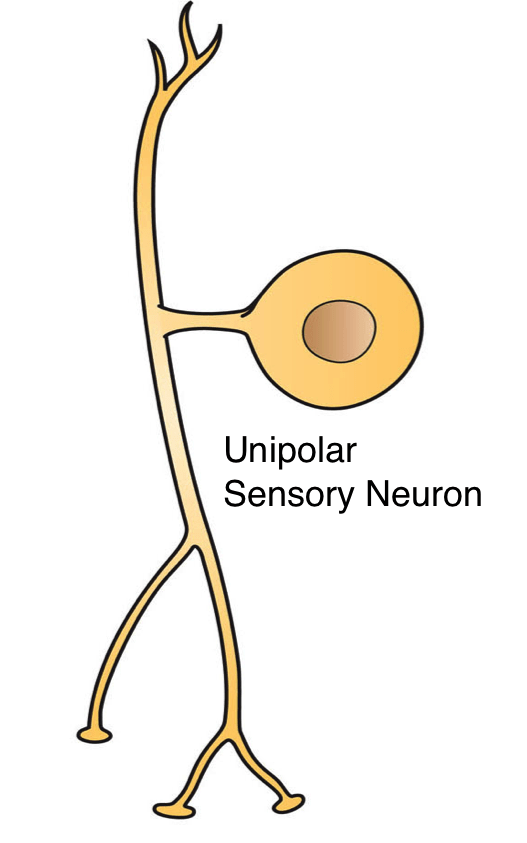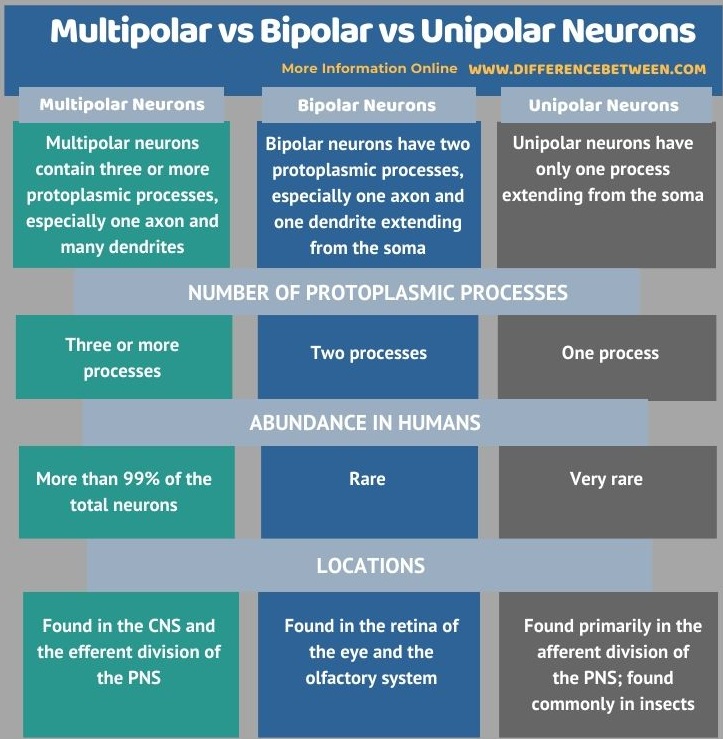Difference Between Multipolar Bipolar and Unipolar Neurons
Table of Contents
The key difference between multipolar bipolar and unipolar neurons is that multipolar neurons have many dendrites and one axon, while bipolar neurons have one axon and one dendrite and unipolar neurons have only one protoplasmic process.
A neuron or a nerve cell is the basic structural and functional unit of the nervous system. It is an electrically excitable cell. Neurons receive signals from the external world via the sensory organs and send them to the central nervous system in order to process. Then, neurons transmit signals from the brain and spinal cord to other parts of the body, especially to muscles and gland cells. In this manner, neurons facilitate communication within our body.
A neuron has three major components: an axon, dendrites and a cell body. Neurons receive signals from the dendrites. Then the signal travels via the cell body to the axon. From the axon, the signal goes to the next neuron through the synapse. Neurons can be unipolar, pseudounipolar, bipolar or multipolar. Most neurons are multipolar, while many are bipolar. However, there are unipolar and pseudounipolar neurons, as well.
CONTENTS
1. Overview and Key Difference
2. What are Multipolar Neurons
3. What are Bipolar Neurons
4. What are Unipolar Neurons
5. Similarities Between Multipolar Bipolar and Unipolar Neurons
6. Side by Side Comparison – Multipolar Bipolar vs Unipolar Neurons in Tabular Form
7. Summary
What are Multipolar Neurons?
Multipolar neurons are the commonest type of neurons, having three or more protoplasmic processes. Generally, these neurons have one axon and many dendrites. More than 99% of the total neurons in humans are multipolar. Therefore, they are the major type of neurons found in the central nervous system and the efferent division of the peripheral nervous system.

Figure 01: Multipolar Neurons
What are Bipolar Neurons?
Bipolar neurons are a type of neurons that have two processes extending from the cell body. Generally, these two processes run in opposite directions from the cell body. One process is an axon while the other process is a dendrite.

Figure 02: Bipolar Neuron
In comparison to multipolar neurons, bipolar neurons are few in number. They are found in the retina of the eye and the olfactory system.
What are Unipolar Neurons?
A unipolar neuron is a neuron that possesses only one protoplasmic process. So, unipolar neurons have only one structure extending from the cell body or soma.

Figure 03: Unipolar Neuron
Generally, unipolar neurons are present in invertebrates, especially in insects in order to stimulate muscles or glands. In mammals, they are primarily found in the afferent division of the PNS.
What are the Similarities Between Multipolar Bipolar and Unipolar Neurons?
- Multipolar, bipolar and unipolar neurons are three of the four types of neurons found in our nervous system.
- They are classified based on the number of processes that extend out from the cell body.
- Moreover, t have protoplasmic processes coming out from the soma.
What is the Difference Between Multipolar Bipolar and Unipolar Neurons?
Multipolar neurons contain three or more protoplasmic processes, especially one axon and many dendrites, while bipolar neurons have two protoplasmic processes, especially one axon and one dendrite extending from the soma and unipolar neurons have only one process extending from the soma. So, this is the key difference between multipolar bipolar and unipolar neurons. In humans, more than 99% of the total neurons are multipolar neurons, while bipolar neurons are rare and unipolar neurons are very rare.
Moreover, multipolar neurons are found in the CNS and the efferent division of the PNS while bipolar neurons are found in the retina of the eye, and the olfactory system and unipolar neurons are found primarily in the afferent division of the PNS and in insects. Thus, this is another difference between multipolar bipolar and unipolar neurons.

Summary – Multipolar Bipolar vs Unipolar Neurons
Based on the number od protoplasmic processes coming out from the soma, there are four types of neurons as unipolar, bipolar, multipolar and pseudounipolar. Multipolar neurons have one axon and many dendrites extending from the cell body. Bipolar neurons have one axon and one dendrite. Unipolar neurons have only one protoplasmic process extending from the cell body. Thus it is the key difference between multipolar bipolar and unipolar neurons. Multipolar neurons are the commonest while there are many bipolar neurons. However, there are unipolar neurons present in the nervous system, but their number is very low compared to the other two types.
Reference:
1. “12.2 Nervous Tissue.” Anatomy and Physiology, OpenStax, 6 Mar. 2013, Available here.
2. “Neurons & the Nervous System.” Human Physiology – Neurons & the Nervous System, Available here.
Image Courtesy:
1. “Blausen 0657 MultipolarNeuron” By BruceBlaus – Own work (CC BY 3.0) via Commons Wikimedia
2. “Bipolar Interneuron” By Artwork by Holly Fischer – CNS Slide 12; PNS Slide 18 (CC BY 3.0) via Commons Wikimedia
3. “Unipolar Sensory Neuron” By Artwork by Holly Fischer – CNS Slide 12; PNS Slide 18 (CC BY 3.0) via Commons Wikimedia
ncG1vNJzZmivp6x7pbXFn5yrnZ6YsqOx07CcnqZemLyue8OinZ%2Bdopq7pLGMm5ytr5Wau2651KWroqifoa6zecGip6ikkad6orrDZqynoaCkuaK%2BjKecrqqfo8Bw